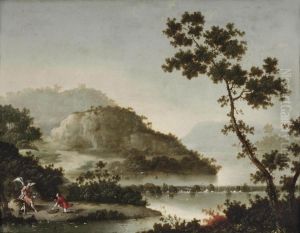Pseudo-Moucheron Paintings
Pseudo-Moucheron is a notional artist, a name assigned by art historians to categorize and study a group of artworks that share stylistic similarities with the works of the Dutch Golden Age painter and draughtsman, Frederick de Moucheron (1633–1686), and his circle, yet cannot be directly attributed to Moucheron himself. This designation is a common practice in art history for organizing and attributing works of art when a direct connection to a specific artist cannot be firmly established but shows considerable influence or stylistic resemblance to that artist's known body of work.
Frederick de Moucheron was renowned for his landscape paintings, often depicting Italianate gardens, classical ruins, and pastoral scenes that were highly sought after in the 17th century. His work was characterized by a meticulous attention to detail, a vibrant palette, and an adeptness at capturing the interplay of light and shadow. Moucheron's influence extended beyond his lifetime, inspiring a number of followers and imitators.
The term 'Pseudo-Moucheron' therefore encompasses a variety of artists who were either directly influenced by Moucheron, worked within his workshop, or whose works were previously misattributed to Moucheron. These artists continued to produce landscapes and scenes that bore a marked resemblance to Moucheron’s style, including the use of architectural elements, the depiction of foliage, and the overall composition. However, despite these similarities, closer examination and advanced techniques in art analysis have led scholars to reclassify these works under the umbrella of Pseudo-Moucheron, acknowledging their stylistic debt to Moucheron while recognizing the individual contributions of these unidentified artists.
The study of Pseudo-Moucheron works allows art historians to explore the nuances of influence and apprenticeship within the Dutch Golden Age of painting, shedding light on the dynamics of artistic production and the diffusion of stylistic trends across Europe during this period. It also underscores the challenges inherent in art attribution, particularly in periods where documentation is scarce and the practice of signing artworks was not uniformly observed.
